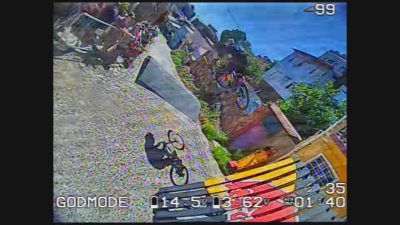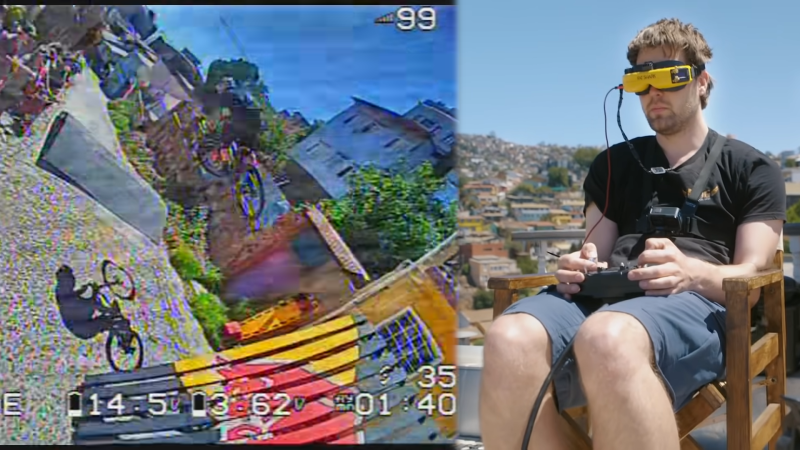Drones have revolutionized the world of videography in perhaps the biggest way since the advent of digital hardware. They’re used to get shots that are impractical or entirely impossible to get by any other means. The [Dutch Drone Gods] specialize in such work. When it came to filming an urban mountain bike race in a dense Chilean city, they had to bust out some serious tricks.

Typically, running a drone chase cam behind a biker would require some good first-person flying skills and a quick drone. However, for the Red Bull Valparaiso Cerro Abajo urban downhill event, this alone would not be enough. The tight course winds down staircases between thick concrete walls and even through houses, presenting huge challenges to maintaining signal integrity. Without a clear video signal, the pilot can’t fly the drone without crashing.
To make this all possible, the team used a variety of techniques to help combat the uncooperative radio environment. Directional antennas were used to target different sections of the course. Additionally, a second drone was flown high above the course carrying a radio repeater, helping provide a better line-of-sight contact to the camera drone following the riders when the buildings would otherwise block the signal to the pilot.
Even with all this work, the signal was still scratchy and would cut out at some points. However, with a bit of blind faith when cutting through the worst areas, the [Dutch Drone Gods] and the [Red Bull] team were able to put together an amazing FPV drone shot shadowing [Tomas Slavik] on his run down the extremely difficult urban course.
Details on the precise hardware are scarce. However, it’s something that any experienced drone builder could probably whip up without too much trouble. The idea of using a drone-based repeater is particularly exciting, and something we’re sure could help out many pilots who find themselves operating in difficult urban environments.
We’ve seen plenty of great FPV stories over the years, from early experiments in the 1980s to fun DIY cockpit builds of today. Video after the break.
















Insane shots. This really sent chills over my spine!
Any idea of the drone + motors they are using?
Is the repeater for the FPV goggles? What’s available under the heavy hands of the FCC?
This is Chile where the laws are probably more relaxed or they got special permission to do it. I think here in the UK it would be illegal though unless they gave you permission which they won’t do just to hobbyists, it would have to be professionals working with a big company like red bull.
Even flying like this is illegal in the UK, you are too close to buildings, you don’t always have a visual line of sight, which is the biggest one, if you want to use goggles then you have to have someone stood beside you and the drone always has to be in their line of sight.
“Illegal” without permission. Getting permission for unusual activities (from both OFCAM and the CAA) is easier than you may expect. It does require planning and risk assessment, which is why it’s prohibited for the general public, but once you actually do your homework you’ll find those agencies amenable to quite a lot.
I wonder how much paperwork you’d need for “I’d like to fly a drone straight through someone’s house at high speed. Oh, and I won’t have signal so I’ll just have to aim straight and hope nobody sticks their head out through a door at the wrong time”? ;)
(@08:47 or so, someone tries to take a photograph at *almost* the wrong time)
The transmission laws are quite lax here. Just stay away from the maritime (we are a coastal city), emergency, and communications bands, and you are ok (Ok in the sense that you won’t get the police in 5 minutes around you). Police here is not even near to “technologic competent” to track a signal.
For the drone part. Yes, you are required by law here to get licensed as a professional drone if you are flying over the city (You know… Legal liability in case of accident and stuff). And yes, in this case you will get law enforcement over if you are caught flying without license. The body that enforces that here is not the police, is army since the DGAC is managed by the army (Or DGCA, Directorate General of Civil Aviation in english).
Awkward chair.
I’d rather choose to ride this bike than fly this drone. Pilot’s job is really tough one. Drone can be fixed but imagine hitting spectator with it….
So what technology did they use? You got controller signal and Video signal.
It looks like they are using a TBS Crossfire module on a Mambo TX for the radio control link, & they’re using an analog VTX for the FPV feed as it allows them to use the repeaters and a good ground station to feed the signal to the FPV goggles
inside the house the drone was to crash against a photograph….
“The tight course winds down staircases between thick concrete walls and even through houses”
Honey! We’re having guests. Break out the good china.